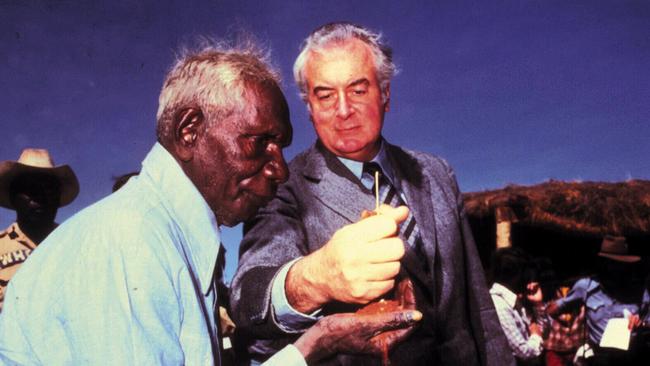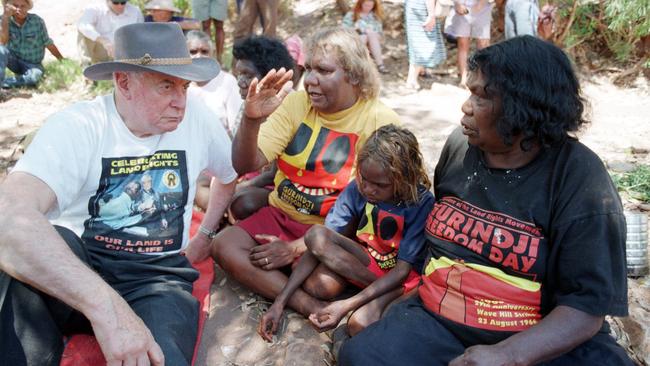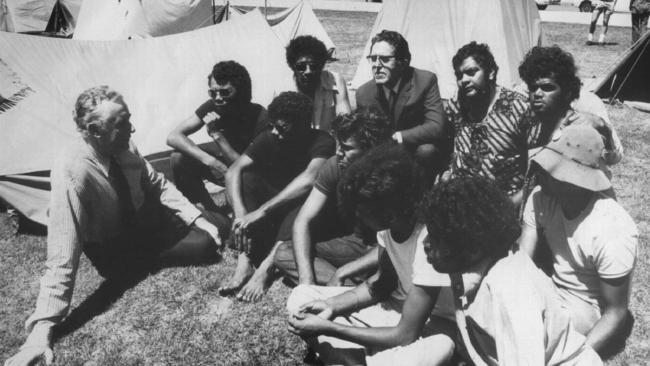Don’t blame 1788: the Whitlam years undermined Aboriginal Australia


Yet reality tells a very different story. Were 1788, and the train of colonial occupation that followed on from that, the primary cause, then you wouldn’t find such wide variation among Indigenous Australians. Indigenous Australians in urban areas and regional centres are hard to distinguish from the rest of the population in those places for levels of wealth, health, education and life outcomes.
The human crisis that produces and reproduces the Gap is much more clearly locatable. It is in the remote outstations of homeland settlements, and around some towns in isolated parts of the Australian interior. It is where there is no economic life outside the government provision of welfare and social services, and no jobs other than those government creates. These places, where basic social order and safety have largely vanished, have been described by Noel Pearson as worse than Third World countries.
Let’s face it: 1973 and 1974, not 1788, better explain this long-scale traumatic hurt and human damage. Those are the years when the new policy of self-determination, and the remote homelands ideal, properly took hold.
The idea that Indigenous peoples should themselves collectively decide the terms on which they would engage with Western life and settler society first emerged in the 1950s, thanks in no small part to the Australian Communist Party. As of 1931, communists argued that indigenous minorities in the advanced capitalist countries were oppressed colonial peoples. The glorious Soviet Socialist republics were “self-determining”, they declared – so should be indigenous minorities.
In an age of decolonisation, the idea had obvious appeal. Canadian prime minister Pierre Trudeau, who believed separating indigenous from other Canadians was a retrogressive step, and an inherently undemocratic one at that, issued a white paper, An End to Separatism, against it.
In Australia, Paul Hasluck, the commonwealth minister for states and territories, and thus the Indigenous people in the Northern Territory, shared Trudeau’s views. Under his stewardship in the 1950s and 1960s, government repudiated the policy of protection that dominated the first half of the 20th century.
There is a solid argument advanced by Tim Rowse, an emeritus professor at Western Sydney University, that protection helped stabilise and rebuild the Indigenous population. But it undeniably treated Aborigines as inherently different, second-class citizens, to be kept apart from the ordinary population.
Hasluck instead sought a system “under which Aborigines were recognised as Australian citizens and were regarded as having the same status and rights as other Australian citizens”. Aborigines should be equals, treated equally. It was through Hasluck that Aborigines regained much of what they’d lost or been denied under protection: civil rights, and the right to vote federally, in 1962.
But after Harold Holt’s drowning, Hasluck narrowly lost the partyroom vote to John Gorton and shortly after effectively left public life. With Hasluck gone no one else seriously pushed back against the new policy concept of self-determination.

Conflated with the shame of the recently junked White Australia policy, assimilation and even integration became bogey words, freighted with the stigma of racism. Hasluck’s policy was condemned for violating the Indigenous right to decide for themselves.
Like multiculturalism – another buzzy, yet originally nebulous word that became policy without public debate about what it meant – self-determination germinated under the Coalition, was supercharged under Gough Whitlam, and then became orthodoxy. Even to question it was to be tarred with hankering for the bad old days of assimilation. Yet self-determination produced failure on a vast, indeed cataclysmic scale.
Activist bureaucrats such as Herbert “Nugget” Coombs enthusiastically endorsed the idea that Indigenous communities in remote regions should be established largely outside modern capitalist Australia. After Whitlam’s 1972 election victory unemployment benefits were made available to all Indigenous people, even if they lived in communities where there were no jobs. It proved to be one of the most poisonous policy decisions of the 20th century.
In the 1950s and 1960s Aborigines had been employed at remote settlements and missions in government-run enterprises, which enabled them to work and live there. Piggeries, orchards, chicken runs, vegetable gardens, sawmills, bakeries and butcheries flourished. After 1972 young people knew they could get paid more money by not working – “sit-down money”, or the dole. The enterprises collapsed.

In many areas self-determination’s wave of social destruction was made worse by the equal wages decision of 1967. On pastoral stations Indigenous cattlemen worked in a largely cashless economy. They were paid for work largely in rations, clothes and basic accoutrements, while continuing to work and live with their families on traditional country. The rations were often paid to the women, giving them considerable influence.
Once equal pay came in, pastoralists switched even more quickly to new technology, and to more skilled workers to run their stock. Combined with the total loss of incentive to work from sit-down money, and the new ubiquity of the modern cash economy – including guns, grog, pornography and drugs – the traditional societies of remote Australia began to rapidly disintegrate, precipitating a dramatic rise in rates of offending and incarceration.
The fate of Vincent Lingiari’s Gurindji people illustrate this tragedy all too vividly. Writer and historian Charlie Ward describes how welfare payments, infrastructure development wages and “unprecedented amounts of funding” from the government fundamentally compromised Gurindji autonomy in the years after Whitlam had poured a handful of sand into Lingiari’s open palm in 1975. Younger generation Gurindji refused to work in the Gurindji-operated cattle operation, rejecting their elders’ traditional authority.
A society that “had masterfully sustained itself by hard work and self-motivation” fell apart, chiefly “as a result of government assistance given under policies of Aboriginal self-management”.
Indigenous policy has been our greatest failure. Ultimately, it is not just a failure of policies but of ideas. In a society where all Australians depend on each other – economically, socially, politically – the notion that any group can be “self-determining” is a fantasy. Fifty years after the Whitlam government raised that fantasy into a religion, it’s time reality was given a stronger say.
Alex McDermott is an independent historian.



Since the defeat of the Indigenous voice to parliament referendum, Indigenous truth and justice commissions have continued to extend their reach throughout different Australian states. They are all based on the assumption the Uluru Dialogues articulated: the problems that plague Indigenous communities can be traced back to the original trauma of dispossession.